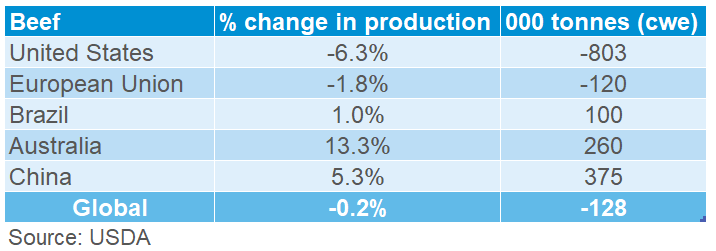USDA forecasts mixed fortunes for global meat markets in 2023
Wednesday, 26 October 2022
The USDA has released its latest forecasts for global beef, pork and chicken production and trade.
Beef
Global beef production is forecasted to see marginal decline in 2023 to 59.2 million tonnes. Although production gains are expected in China, Brazil, and Australia, these will be offset by declines in the US and the EU.
Global exports are also forecast to decline, dropping 1.2% in 2023 to 12.1 million tonnes. This is linked to lower demand, particularly from China. Brazil is expected to achieve record high exports as key competitors such as Argentina, Paraguay, Uruguay, and India see supplies tighten. Reduced production is also expected to limit shipments to Southeast Asia from the US and Canada, which is anticipated to benefit Australia.
Pork
Global pork production is forecast to grow by 1.0% in 2023 to 111.0 million tonnes. This growth is predominantly driven by increased production in China (+2.0%). The US, Brazil and Mexico are also forecast to increase production by 0.7%, 1.6% and 4.6% respectively. Rising feed and energy costs, environmental restrictions and weaker demand means production in the EU and UK is expected to decline.
Although production is pegged to grow in 2023, global exports are forecast to decline 1.6% to 10.5 million tonnes. This is predominantly driven by lower import demand from China where the increased domestic supply will displace the need to import. EU exports are forecast to drop by 3.6% in 2023 as a result of the reduced opportunity to ship pig meat to China, as well as lower production. Import demand in the Philippines is also expected to decline (-18.2%) as, despite issues with ASF, import favouring policies come to an end at the end of 2022.
Chicken
Global production of chicken meat is forecast 1.8% growth to 102.7 million tonnes in 2023. Despite high feed and energy costs squeezing profitability globally, all major producers other than China are expected to see an expansion in production. This is spurred on by robust demand as consumers seek lower-cost animal proteins amid rising food prices.
Global exports of chicken meat are forecast to increase by 3.7% in 2023 to 14.1 million tonnes. The growth is driven by strong demand in Brazil, Mexico, Saudi Arabia, the US and EU. Brazil looks to be well positioned to fulfil most of this increased demand as its key competitors struggle to grow exportable supplies. Competitive pricing, EU market access, and the ability to supply halal product combine to make it the world’s leading exporter, with over one-third of global shipments.

Sign up for regular updates
Subscribe to receive pork market news straight to your inbox. Simply complete our online form.
While AHDB seeks to ensure that the information contained on this webpage is accurate at the time of publication, no warranty is given in respect of the information and data provided. You are responsible for how you use the information. To the maximum extent permitted by law, AHDB accepts no liability for loss, damage or injury howsoever caused or suffered (including that caused by negligence) directly or indirectly in relation to the information or data provided in this publication.
All intellectual property rights in the information and data on this webpage belong to or are licensed by AHDB. You are authorised to use such information for your internal business purposes only and you must not provide this information to any other third parties, including further publication of the information, or for commercial gain in any way whatsoever without the prior written permission of AHDB for each third party disclosure, publication or commercial arrangement. For more information, please see our Terms of Use and Privacy Notice or contact the Director of Corporate Affairs at info@ahdb.org.uk © Agriculture and Horticulture Development Board. All rights reserved.


